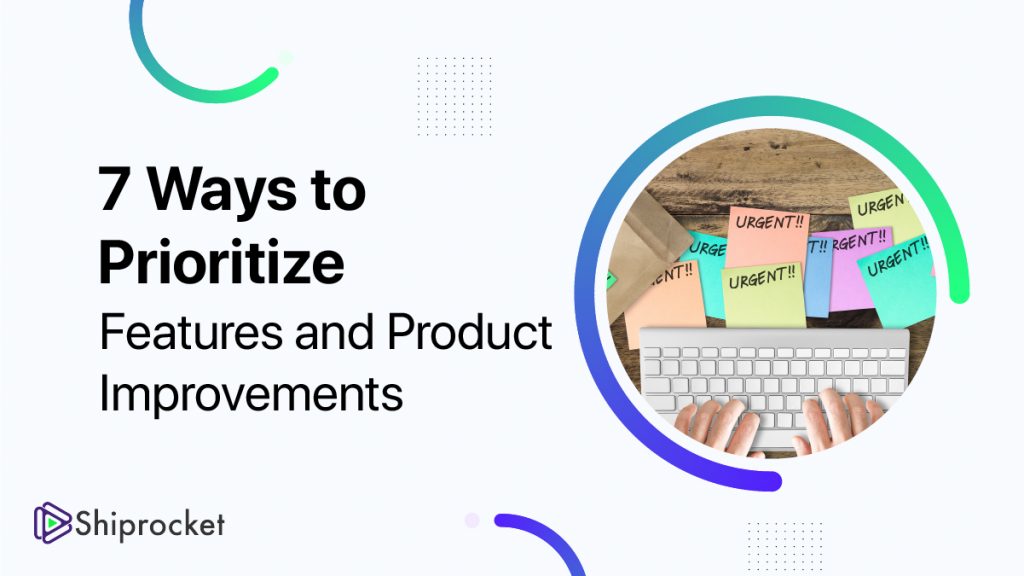- Reasons why Product Managers struggle to prioritize product improvements:
- Here are seven ways to prioritize features and product improvements:
- Determine Your Goals and Objectives
- Understand Your Customers’ Needs and Pain Points
- Consider the Feasibility and Impact of Each Feature
- Evaluate the ROI of Each Feature & Product Improvement
- Use Data to Inform Your Decisions
- Teams should be Aligned in the Prioritization Process
- Regularly Review and Adjust Your Priorities
- Final Takeaway!
Are you struggling to decide which features and improvements to prioritize for your product? It’s a common problem faced by product managers and teams. With limited resources and time, it’s important to make sure you’re focusing on the right things.

As a product manager, one of your key responsibilities is to prioritize features and product improvements. However, this can often be a struggle, especially if you’re working with a limited budget and resources. Here are a few reasons why many product managers struggle to prioritize features and product improvements:
Reasons why Product Managers struggle to prioritize product improvements:
Lack of Clear Goals and Objectives: Without a clear understanding of your goals and objectives, it can be challenging to know which features and improvements are most important to focus on. This is why it’s essential to establish your goals and objectives upfront, and use them as a guiding principle for your prioritization decisions.
Too Many Ideas and Requests: It’s not uncommon for product managers to receive a flood of ideas and requests from various stakeholders, including customers, sales teams, and other departments. While it’s important to consider these suggestions, it can be overwhelming to try to prioritize them all. To manage this, it’s helpful to have a clear process in place for evaluating and prioritizing ideas and requests.

Limited Resources: Product managers often have to make difficult decisions about how to allocate limited resources, such as time and budget. This can make it challenging to prioritize features and improvements, as you may not have the resources to tackle everything on your wish list. To manage this, it’s important to carefully evaluate the ROI of each feature and improvement, and pick those that will have the greatest impact.
Changing Priorities: As your business and your product evolve, your priorities may change as well. This can make it difficult to stay focused on your current priorities and can lead to confusion and frustration among your team. To manage this, it’s important to regularly review and adjust your priorities as needed, and communicate any changes clearly to your team.
Here are seven ways to prioritize features and product improvements:

Determine Your Goals and Objectives
Before you start prioritizing features and product improvements, it’s important to understand your goals and objectives. What are you trying to achieve with your product or service? What problems are you trying to solve for your customers? For example, if your company goal is to reduce losses or increase revenue, you may want to prioritize features that directly impact those areas, such as improving the user experience (UX) to increase customer retention or adding new features that drive sales.
On the other hand, if a proposed modification to the UX or a new feature does not directly align with your company’s goals, it may be best to consider adding it to your backlog for future consideration. The key is to carefully evaluate each opportunity and make sure it aligns with your overall goals and objectives before making a decision on whether to prioritize it or not. Having a clear understanding of your goals and objectives will help you determine which features and improvements are most important to focus on.
Understand Your Customers’ Needs and Pain Points
Understanding the demographics of your customers, including their age, gender, and location, can also be helpful in targeting your product or service to better meet their needs. By identifying the pain points of your customers, you can prioritize which issues need to be addressed in order to better serve them. The severity of the gap between what your customers need and what your product or service currently provides can help guide the level of effort and resources that should be dedicated to addressing these issues.
Consider the Feasibility and Impact of Each Feature
When you have a list of potential features and improvements, it’s important to consider the feasibility and impact of each one. Some features may be technically difficult or time-consuming to implement, while others may have a larger significance on your customers’ experience. Prioritizing features that are both feasible and have a high significance will help you make the most of your resources and efforts.
Evaluate the ROI of Each Feature & Product Improvement
In addition to considering the feasibility and significance of each feature, it’s important to consider the return on investment (ROI) of each one. Will the time and resources invested in a particular feature or improvement be worth it in terms of increased revenue or customer satisfaction? Prioritizing features with a high ROI will help ensure that you’re making the most of your resources.
Use Data to Inform Your Decisions
Data can be a powerful tool when it comes to prioritizing features and improvements. Analyzing usage data and customer feedback can help you identify areas where your product or service could be improved, and can also help you determine which features are most popular with your customers. Utilize this data to inform your prioritization decisions and ensure that you are focusing on the features and improvements that will yield the most significant results.
Teams should be Aligned in the Prioritization Process
Teams will be responsible for implementing new features and improvements, and it is crucial that they remain aligned with the company’s goals and objectives while prioritizing these features. It is recommended to solicit input and perspectives from the teams on the most important features and improvements and to consider their feedback when making final decisions.
Regularly Review and Adjust Your Priorities
As your business and your product evolve, your priorities will likely change as well. It’s important to regularly review and adjust your priorities to ensure that you’re focusing on the features and improvements that are most important to the company objective at any given time. This will help you stay agile and responsive to your customer’s needs and the changing market.
Final Takeaway!
Prioritizing features and product improvements can be a challenging task, but it’s essential for the success of your business. By following these 7 tips, you can make informed, strategic decisions about which features and improvements to focus on, and ensure that you’re making the most of your resources and efforts. Prioritizing features and product improvements can be a challenging task for product managers, but it’s essential for the success of your product. By establishing clear goals and objectives, having a process in place for evaluating and prioritizing ideas and requests, carefully evaluating the ROI of each feature and improvement, and regularly reviewing and adjusting your priorities, you can make informed, strategic decisions about which features and improvements to focus on.
